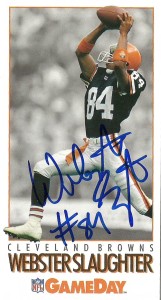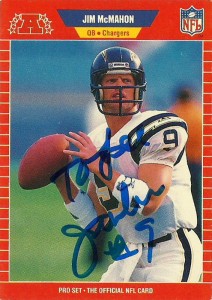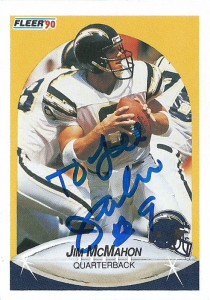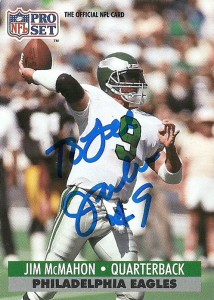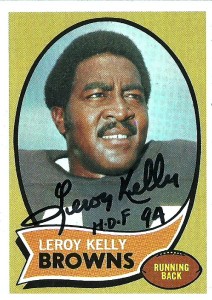 Cards: Topps 1971, Topps 1973
Cards: Topps 1971, Topps 1973
Acquired: TTM 2012, C/o Home
Sent: 12/4 Received: 12/14 (10 days) *
* Signing fee $10.00 per card
Topps classic 1971 effort remains one of my favorites that the company ever did. It’s simplistic design layout along with classic shots of players, really has always caught my eye. Kelly was iconic in his Browns poncho style jacket of the era, that epitomized the grit and elements that his opponent faced in Cleveland, but he excelled in.
Leroy Kelly played in the shadow of runningback Jim Brown for the Cleveland Browns. Not to be outdone by the exiting Brown, Kelly went on to notch many team and league records in his own stead. A bruising runningback in his own right, Kelly was in command on the sloppy Cleveland Browns’ Stadium grass/mud, and carved up many teams of the day. Before he ran the gridiron for the Browns though, he was a standout back for Morgan State Bears and a Black College Football All-American. There he did everything and seldom left the field as a runningback, defensive back, punter, and return man- (after he showed up initially at Morgan St. as a quarterback.) He helped the Bears win a CIAA title. The Browns amazingly nabbed him in the 8th round of the 1964 draft. (No AFL team bothered to draft him at the time.) The knock on Kelly was that he was too small to be playing RB at the time, as most teams featured big backs, so Kelly set out to bulk up to 200 and prove to the league that he would be a wisely invested draft choice.
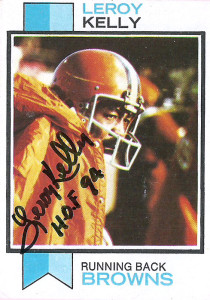 Leroy rushed for 7,274 yards during his career, -rushing for over 1,000 yards his first three years after becoming the starter. He won NFL rushing titles in 1967 and 1968 and was a two-time punt return champion as well. His numbers stand up well in league history with a combined 12,329 all-purpose yards and 90 touchdowns over his career. Injuries took their toll on Kelly, and by 1973 it was the end of the road for him. In 1974 the Browns waived Leroy, and he signed with the Oakland Raiders, but soon thereafter was on the roster of the Chicago Fire of the WFL, but that league folded mid-season. At the time of his retirement, he ranked No. 4 all-time in rushing and combined net yards. As a ‘smaller back’, you can point to Kelly as a prime example of a player who helped revolutionize the thinking regarding the intricacies of the the position of runningback versus halfback or fullback and so on. Leroy was enshrined in the NFL Pro Football Hall of Fame in 1994.
Leroy rushed for 7,274 yards during his career, -rushing for over 1,000 yards his first three years after becoming the starter. He won NFL rushing titles in 1967 and 1968 and was a two-time punt return champion as well. His numbers stand up well in league history with a combined 12,329 all-purpose yards and 90 touchdowns over his career. Injuries took their toll on Kelly, and by 1973 it was the end of the road for him. In 1974 the Browns waived Leroy, and he signed with the Oakland Raiders, but soon thereafter was on the roster of the Chicago Fire of the WFL, but that league folded mid-season. At the time of his retirement, he ranked No. 4 all-time in rushing and combined net yards. As a ‘smaller back’, you can point to Kelly as a prime example of a player who helped revolutionize the thinking regarding the intricacies of the the position of runningback versus halfback or fullback and so on. Leroy was enshrined in the NFL Pro Football Hall of Fame in 1994.
I got really interested in writing Leroy after being tuned into his legacy by another fan who has a site dedicated to Leroy and the Browns. I myself, have always sympathized with Cleveland. Just like the Oilers, the city had their team yanked out from under them. They also have shared similar paths to modern day glory and tragedy. Thus I decided to write Leroy, since he fits the mold of the players I like to get autographs from: Underrated and unappreciated (,well at least by modern day fans).
NFL G/Gs 136 Rush 1727 Yds 7274 Avg 4.2 Td 74 Lg 70 |
Rec 190 Yds 2281 Avg 12.0 Td 13 Lg 68
KR 76 Yds 1784 Avg 23.5 Td 0 Lg 51
PR 94 Yds 990 Avg 10.5 Td 3 Lg 74t
WFL Rush 77 Yds 315 Avg 4.1 Td n/a
Rec 8 Yds 128 Avg 16.0 Td n/a
